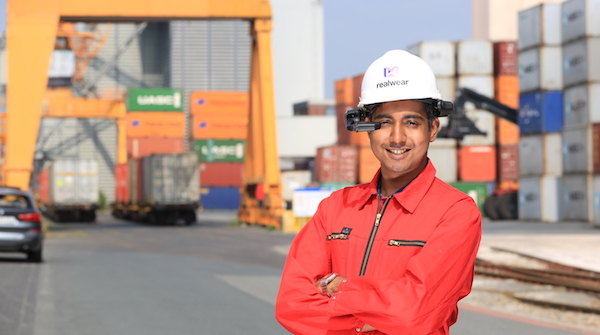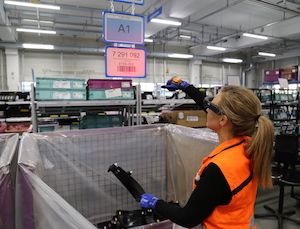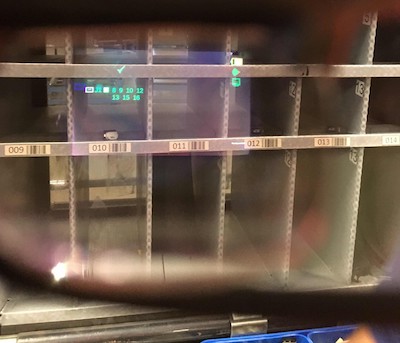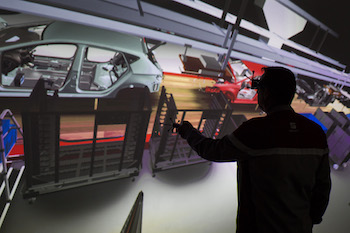A growing number of companies in the automotive industry are embracing the use of augmented and virtual reality technology for tasks such as part picking and inventory management, as well as for training. We look at some of the latest applications
 From enhanced design and manufacturing processes to novel staff training and apprenticeship programmes, the use of augmented reality (AR) and virtual reality (VR) in industrial applications is growing.
From enhanced design and manufacturing processes to novel staff training and apprenticeship programmes, the use of augmented reality (AR) and virtual reality (VR) in industrial applications is growing.
In the automotive logistics sector, a number of vehicle-makers and logistics service providers have been prompted to investigate the potential of technology such as glasses or goggles that can overlay a heads-up display onto a normal view of the world. Besides innovative pilot projects, some are even moving towards the establishment of AR systems in full operation.
Many early examples have focused on warehouse management and product picking, but, as the technology improves and the range of products on the market increases, there is some evidence that the use of this technology could go much further.
As Irma Gilbert, business development manager at Liverpool-based technology start-up Connect 4.0 explains, AR technology can be put to a large number of uses, from maintenance and training to prototyping and product or part visualisation, as well as improving productivity and safety.
“For automotive, the luxury segment is also using AR to enhance production, reduce cost of design and provide a better customer experience,” she says.
When it comes to the use of AR in logistics applications, one of the front-runners is BMW, which is currently using smart glasses in a pilot project at its Munich plant. As Nela Murauer, head of the Smart Glasses Project, explains, the company is trialling glasses like those from ODG, Vuzix and Google, which are “technically used like a monitor worn on the nose” to display picking information in the worker’s field of vision, while interaction with the warehouse management system is achieved via barcode scans.
 A two-month study suggests a 22% time-saving and a 33% reduction in errors over a typical eight-hour shift when using the technology, and employees have proved to be satisfied with the user interface, says Murauer – though there have been some reports of hardware-related discomfort to the nose and temples, she admits.
A two-month study suggests a 22% time-saving and a 33% reduction in errors over a typical eight-hour shift when using the technology, and employees have proved to be satisfied with the user interface, says Murauer – though there have been some reports of hardware-related discomfort to the nose and temples, she admits.
Jan Cirullies, head of logistics at the Fraunhofer Institute for Software and Systems Engineering (ISST) in Germany, says one of the main applications for AR in warehouses is to support operational processes, either as a permanent tool or a temporary aid. One example of a permanent application is pick-by-vision technology, in which AR devices are used to highlight boxes or shelf locations to pick from, or to optimise packing instructions.
In terms of temporary applications, meanwhile, “AR can also train new staff, introduce new processes or provide guidance on rarely performed tasks – for example, certain maintenance procedures carried out by an operator,” says Cirullies.
Among those deploying the technology is VW Group, which is currently running a number of AR-related initiatives across several group companies. Skoda, for example, has introduced an innovative video mapping scheme at its Mladá Boleslav facility in the Czech Republic in an effort to assist staff with material picking by providing extended information and highlighting any process errors. Elsewhere, VW is using AR goggles to present digitalised training information about a variety of procedures that apprentices can quickly access as they are working – something the company says should help to foster self-teaching skills and enable trainees to adapt their learning behaviour to conditions at the plant.
Another OEM that has begun introducing AR technology is Ford, which is committed to ramping up the use of a range of new technologies including 3D printing, AR, VR and robotics at its new $45m Advanced Manufacturing Center in Redford, Michigan.
[mpu_ad]Virtual trainingAs for VR (which differs from AR in that it involves complete, rather than partial immersion in the digital world), German logistics service provider DB Schenker is currently working closely with Fraunhofer IML on a range of automotive industry experiments, the first of which is an employee training programme devised in the collaborative Enterprise Lab for Logistics and Digitalisation that is designed to improve packaging and order picking processes.
According to DB Schenker, the programme is based on a total of six exercises – each of which instructs learners about the various steps involved by encouraging ‘playful’ learning. Following a successful introduction at the DB Schenker site in Leipzig, the company plans to expand its use to other contract logistics sites.
Frank Lampe, SVP of marketing at UBiMAX, points out that AR, in combination with computing devices like smart glasses, smartphones, tablets and wrist-mounted computers, is commonly used for intralogistics tasks like managing incoming parts, order picking and sorting-sequencing.
Especially for combined just-in-time and just-in-sequence scenarios, he says: “AR solutions can replace, or better said, digitise Kanban systems, and help kitting. We also have customers who pre-assemble parts, like interior door handles, using AR to deliver them with zero errors to the production line.”
Vision pickingElsewhere, Simon Woodward, head of accelerated innovation and digitalisation at DHL Supply Chain UK and Ireland, says applications for AR, as well as VR, within the logistics sector are “widespread” and the company has already incorporated them into its business operations in a number of ways.
“From planning and training to order picking and packing, we are using AR and VR to drive the next wave of supply chain innovation, making operations simpler and more efficient,” he comments.

One interesting example has been the introduction of smart glasses to provide visual displays of order picking instructions, along with information on where items are located and where they need to be placed on the picking cart. According to Woodward, this enables completely hands-free order picking, with every step carried out through the glasses, rather than a combination of handheld scanner and traditional picking list, making the experience more user-friendly and efficient.
“In addition, we’ve also incorporated VR into our training strategy. We’ve created computer-simulated 3D immersive training environments, which allow users to take part in a number of scenarios without the need for traditional classroom training,” he says.
“This has been hugely beneficial because, as well as providing more realistic scenarios in a safe environment, our employees have been able to access the training quickly and on multiple occasions, if needed.”
Benefits and challengesWhen it comes to assessing the main benefits of using AR in logistics applications, Cirullies suggests that logistics service providers can expect to achieve a 30% improvement in total process costs, thanks to gains like shorter lead times and lower error rates.
He also believes that AR provides companies across the automotive logistics sector with potentially lifelong technological support. However, despite the undoubted upsides, Cirullies admits that the technology for what he describes as ‘full’ AR – or even ‘assisted reality’ devices featuring monocular and/or fixed positions for information shown in glasses – is “still lacking industry-ready maturity”.
“Hence, scenarios with temporary application are interesting. Even if the device is not suitable for a whole shift – perhaps because of weight-related ergonomic reasons or battery life – selected actions might be supported,” he says.
Based on his experience at UBiMAX, Lampe suggests that AR can lead to 15-35% faster processes depending on existing efficiency levels, as well as near-zero errors in picking. He also points to high employee satisfaction thanks to more ergonomic work processes via hands-free work and the removal of the need to walk to a fixed computer terminal, as well as an end to searching paper lists and a reduction of unnecessary tasks. In his view, AR can also facilitate more flexible deployment of staff “due to better worker guidance and intuitive mobile visual information provision”.
“Even new or temporary staff can fulfil tasks at top quality as the AR solution shows what to do and how to do it. Via remote support calls through the smart glasses, workers can also contact their manager and get help, guidance or approvals,” he adds.
Woodward goes as far as to say that both AR and VR have the potential to transform the logistics environment, thanks to their ability to improve efficiency.
“We know that vision picking has improved productivity, reduced errors and positively supported our warehouse operatives in their daily work, with an average uplift of 15% in the number of picks per hour, compared to a conventional approach,” he says.
 “We don’t see any limitations in terms of the technology itself, but one of the most common barriers to the adoption of technologies like AR is the initial investment. However, as with any technology, the price will start to fall as demand increases and we can expect these types of application to become commonplace,” he adds.
“We don’t see any limitations in terms of the technology itself, but one of the most common barriers to the adoption of technologies like AR is the initial investment. However, as with any technology, the price will start to fall as demand increases and we can expect these types of application to become commonplace,” he adds.
For Murauer, the main benefit of AR lies in the “parallelisation of order reading, gripping and scanning, and the associated time savings”, with limitations including the “contradiction of light glasses that can be worn for eight hours and the possibility of complete augmentation, for example, with the Microsoft Hololens, by sensors and depth cameras”.
“Also the battery life does not correspond to a full shift. Some glasses become hot during use. Here, the market must provide new models to solve these problems. The integration of requirements from industry, [like] shatterproof glass, a solution for hygiene issues when used together [and] a solution for spectacle wearers must also be ensured,” she says.
Essential in futureLooking ahead, Gilbert suggests the use of AR in logistics will expand over the next five to ten years and, as we better understand how to integrate new and legacy systems, that options to develop new applications for repair, maintenance and product development will come to the fore.
Murauer agrees, predicting that while BMW is currently dealing mainly with the flexible connection of different wearable devices via a common interface, AR in logistics will become a big topic in the coming years, as the hardware market offers improved models.
“Potential use cases range from order picking, special training applications and maintenance use cases for transport systems to visualisation and optimisation of the material flow, for example overlay of target and actual status,” she comments.
Cirullies, too, envisages a number of key developments in the use of AR technology for automotive logistics operations over the next few years. One, he suggests, will be the use of the technology in combination with VR as a closed-loop solution to plan and execute processes as well as design workstations.
“In early stages, places and process can be designed virtually. This model is the first stage of a ‘digital twin’ of a logistics system,” he comments. “This digital twin can then be continuously used to train staff and as a basis for augmented information during operations. Therefore, I think that AR will become one essential interface between humans and the digital twin – that is, at the cyber level.”
Ultimately, says Woodward, digitalisation will have a major impact on revenue growth in the supply chain, and AR will have a vital role to play in this.
“As the technology becomes more sophisticated, paradigms within logistics will shift – resulting in operations becoming predictive, as opposed to forecasted; processes and transport becoming automated, not manual; and services becoming personalised, rather than standardised, making for a far superior customer experience,” he concludes.
What are the main applications of AR in automotive logistics? What technology is being used and in what way?
Augmented reality is an ‘edge’ technology that basically gives visual information to the user about what he is seeing. Most typical applications include training for repetitive activities, remote support for technical interventions or computer-guided quality checks.
In terms of logistics, the main applications can be divided into four areas:
•Quality control, to confirm picking or supply processes
• Online stock and inventory control
• Guidance in complicated processes
• Support in documentation processes.

Is Seat currently using AR technology for automotive logistics applications, either in full operation or pilot projects?
Seat has made several tests to validate this technology in order to assure quality during picking processes. We continue to conduct tests with different wearables like smart watches or mobile phones.
What are the main benefits of using AR in logistics applications? What are the main challenges and limitations?
The main benefits of using AR in logistics are to give as much information as possible about the product to the worker. Information like stock coverage, FIFO [first-in, first-out] data and quality confirmation is a very powerful tool to connect the worker with the factory.
Currently, the main challenges are the ergonomics of wearable devices and online and accurate data management. Moreover, this technology will have to find its place between other pick-by systems that can give the same information to the worker.
What are the latest developments in AR for logistics? Do you think its use in this area will expand in the coming years?
Processing and connectivity speed has been a key factor in the development of this technology. Also user experience and wearables are being developed really fast.
Reaching a truly ergonomic process will be the key factor for this technology to significantly expand.
As stated, the possibility of connecting the worker with all the data is a very powerful tool. This technology will mean workers are not just obeying orders but have all the information in their hands to make the best decision at every moment.
Regarding documentation management, it can also be a middle state in the road to the full digitalisation of product documentation.

























![Global[1]](https://d3n5uof8vony13.cloudfront.net/Pictures/web/a/d/s/global1_726550.svgz)












